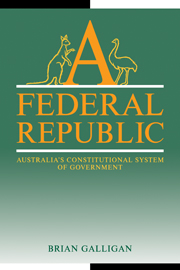Book contents
- Frontmatter
- Contents
- Tables and figures
- Preface
- Dedication
- Introduction
- 1 A federal republic
- 2 Federal theory and Australian federalism
- 3 The Senate and responsible government
- 4 Labor and the Australian Constitution
- 5 The referendum process
- 6 The protection of rights
- 7 The High Court and the Constitution
- 8 Intergovernmental relations and new federalism
- 9 Fiscal federalism
- 10 Towards and beyond 2001
- Bibliography
- Index
2 - Federal theory and Australian federalism
Published online by Cambridge University Press: 05 November 2011
- Frontmatter
- Contents
- Tables and figures
- Preface
- Dedication
- Introduction
- 1 A federal republic
- 2 Federal theory and Australian federalism
- 3 The Senate and responsible government
- 4 Labor and the Australian Constitution
- 5 The referendum process
- 6 The protection of rights
- 7 The High Court and the Constitution
- 8 Intergovernmental relations and new federalism
- 9 Fiscal federalism
- 10 Towards and beyond 2001
- Bibliography
- Index
Summary
Despite federalism's popularity as a preferred system of government and its extensive use throughout the world, there is a curious ambivalence about federal theory. Many writers on federalism have eschewed federal theory in favour of getting on with the job of examining practical issues and problems. Such a course is futile, however, because theory is no sooner banished from the front door than it re-enters, disguised, through the back door. Ideas are no less powerful in politics than in economics where, as Keynes so sagely pointed out, ‘Practical men, who believe themselves to be quite exempt from any intellectual influences, are usually the slaves of some defunct economist’ (1936: 383). Likewise, practical analysts of federalism invariably reproduce old theories or give vent to their own unreflective assumptions about the character and desirability of federalism.
This chapter is concerned with federal theory and how it informs and explains Australian federalism. The first part of the chapter explains federalism in terms of its liberal and participatory dimensions. The liberal dimension of federalism, evident in the division and restriction of government powers, accounts for the strong anti-federal tradition in Australian political history and the Labor Party's abolitionist plank. The participatory dimension, on the other hand, explains why federalism has been so resilient and remains the central organising principle of Australian government and politics despite such opposition.
- Type
- Chapter
- Information
- A Federal RepublicAustralia's Constitutional System of Government, pp. 38 - 62Publisher: Cambridge University PressPrint publication year: 1995

